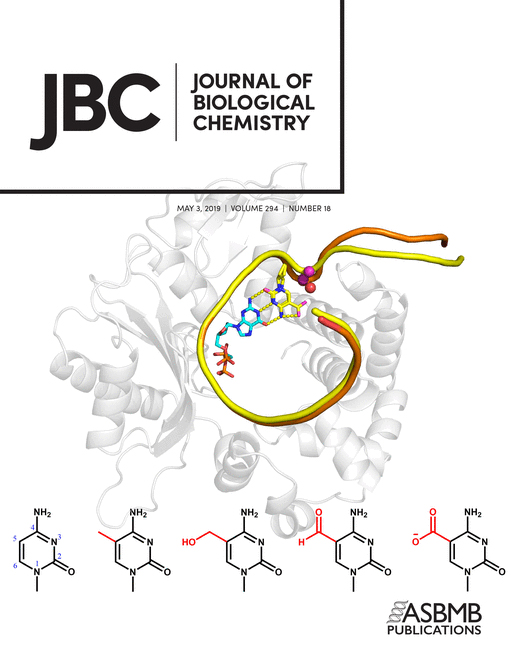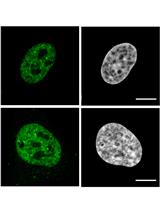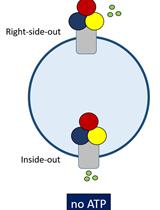- EN - English
- CN - 中文
Stopped-flow Light Scattering Analysis of Red Blood Cell Glycerol Permeability
红细胞甘油通透性的Stopped-flow 光散射分析
发布: 2020年08月20日第10卷第16期 DOI: 10.21769/BioProtoc.3723 浏览次数: 4721
评审: Manjula MummadisettiWoojong LeeAksiniya Asenova
Abstract
Stopped-Flow Light Scattering (SFLS) is a method devised to analyze the kinetics of fast chemical reactions that result in a significant change of the average molecular weight and/or in the shape of the reaction substrates. Several modifications of the original stopped-flow system have been made leading to a significant extension of its technical applications. One of these modifications allows the biophysical characterization of the water and solute permeability of biological and artificial membranes.
Here, we describe a protocol of SFLS to measure the glycerol permeability of isolated human red blood cells (RBCs) and evaluate the pharmacokinetics properties (selectivity and potency) of isoform-specific inhibitors of AQP3, AQP7 and AQP9, three mammalian aquaglyceroporins allowing transport of glycerol across membranes. Suspensions of RBCs (1% hematocrit) are exposed to an inwardly directed gradient of 100 mM glycerol in a SFLS apparatus at 20 °C and the resulting changes in scattered light intensity are recorded at a monochromatic wavelength of 530 nm for 120 s. The SFLS apparatus is set up to have a dead time of 1.6-ms and 99% mixing efficiency in less than 1 ms. Data are fitted to a single exponential function and the related time constant (![]() , seconds) of the cell-swelling phase of light scattering corresponding to the osmotic movement of water that accompanies the entry of glycerol into erythrocytes is measured. The coefficient of glycerol permeability (Pgly, cm/s) of RBCs is calculated with the following equation:
, seconds) of the cell-swelling phase of light scattering corresponding to the osmotic movement of water that accompanies the entry of glycerol into erythrocytes is measured. The coefficient of glycerol permeability (Pgly, cm/s) of RBCs is calculated with the following equation:
where
Background
The movement of water and solutes across biological and artificial membranes can be analyzed using different approaches. Assessing the rate with which the volume of any sealed particle lined by a membrane changes following the osmotically-driven movement of water represents an indirect approach widely used to measure biophysically the water and solute permeability of the particle specimen.
The Stopped-Flow Light Scattering (SFLS) method was devised to analyze the kinetics of rapid enzymatic reactions accompanied by significant changes of the molecular weight and/or shape of the reacting substrates (Riesner and Buenemann, 1973). SFLS soon proved to be an implementable, reliable and reproducible spectroscopic technique with a number of advantages and only few limitations. While the original method remains extensively used to study the chemical kinetics of fast reactions in solution the conventional SFLS apparatus has been modified to allow the measurement of the coefficient of solute and osmotic water permeability (Ps and Pf, respectively; cm/s) of both biological and artificial membranes (Terwilliger and Solomon, 1981; Mlekoday et al., 1983; van Heeswijk and van Os, 1986). SFLS is largely employed to assess the Ps and Pf of whole cells (Yang and Verkman, 2002; Maggio et al., 2018), organelles, extracellular vesicles (Calamita et al., 2005 and 2006; Ivanova et al., 2008; Soria et al., 2010), and vesicles of any kind of biological membrane (Shi et al., 1990; Calamita et al., 2012; Gena et al., 2017; Miyazawa et al., 2018). The method is also used to measure the permeability of artificial membranes such as liposomes (Zeidel et al., 1992 and 1994; Harris et al., 1994; Agre et al., 1999; Müller-Lucks et al., 2013) and polymersomes (Erbakan et al., 2014; Loo et al., 2017). SFLS is also employed to evaluate the Arrhenius activation energy (Ea; kcal/mol) of water and solute transport based on the temperature dependence with which molecules cross the membrane (Agre et al., 1999; Yang and Verkman, 2002; Mathai et al., 2001; Mouro-Chanteloup et al., 2010).
Here, we describe a protocol of SFLS to measure the glycerol permeability of isolated human RBCs in presence or absence of three isoform-specific blockers of AQP3, AQP7 and AQP9 (Jelen et al., 2011; Sonntag et al., 2019), three aquaglyceroporin channels conducting glycerol, water and some other molecules. AQP3, AQP7 and AQP9 are variously expressed in the body playing roles both in health and disease (Yang et al., 2001; Hara-Chikuma and Verkman, 2006) and triggering strong pharmacological interest (Calamita et al., 2018). RBC glycerol permeability is measured after their exposure to different concentrations of the three blockers (vs. control RBCs treated with the vehicle alone). Useful information is acquired regarding the efficiency, selectivity and potency of the compounds in blocking the Aquaglyceroporin-facilitated glycerol transport as well as their preclinical sustainability (solubility, toxicity) for drug developments.
Materials and Reagents
- Fifteen ml conical tubes (FalconTM) (Fisher Scientific, catalog number: 14-959-53A )
- Sterile individually packaged 5 ml pipettes (SARSTEDT, catalog number: 86.1253.001 )
- BD Vacutainer spray coated K2EDTA tubes (BD, catalog number: 366643 )
- Fresh human whole blood from healthy donors
Collected following standard clinical procedures. The blood is drawn by direct puncture to the human vein located in the antecubital area of the arm and collected in in K2EDTA tubes. After washings in DPBS, keep the blood at room temperature and proceed directly to stopped-flow light scattering measurements. - HTS13286 [AQP9 inhibitor (Jelen et al., 2011; Sonntag et al., 2019)], 2-[(4-Methyl-5-pyridin-4-yl-1,2,4-triazol-3-yl)sulfanyl]-N-(5-thiophen-2-yl-1,3,4-thiadiazol-2-yl) acetamide, MolPort, MolPort-002-839-693, stable, storage 2.5 mM stock solutions dissolved in DMSO at -20 °C. After freezing, warm well (15 min at 37 °C and vortex) before use
- DFP00173 [(AQP3 inhibitor (Sonntag et al., 2019)], 1-(2,6-dichlorophenyl)-3-(5-nitrothiophen-3-yl) urea, MolPort, MolPort-002-897-426, stable, storage 2.5 mM stock solutions dissolved in DMSO at -20 °C. After freezing, warm well (15 min at 37 °C and vortex) before use
- Z433927330 [(AQP7 inhibitor (Sonntag et al., 2019)], ethyl 4-(3-(4-(1H-pyrazol-1-yl)benzyl)ureido) benzoate, ENAMINE, MolPort-002-897-426, stable, storage 2.5 mM stock solutions dissolved in DMSO at -20 °C. After freezing, warm well (15 min at 37 °C and vortex) before use
- Dulbecco’s Phosphate Buffer Saline (DPBS) (EuroClone SpA, catalog number: ECB4004L ), storage at 4 °C; shelf-life: 24 months from date of manufacture
- Glycerol (Sigma-Aldrich, catalog number: G7757 ), very stable, storage at room temperature, shelf-life: 3 to 5 years from date of manufacture
- Dimethyl Sulfoxide (DMSO) (Sigma-Aldrich, catalog number: D8418 ), very stable, storage at room temperature in a dry place, since DMSO is known to be hygroscopic, shelf-life: 3 to 5 years from date of manufacture
- Hypertonic solution consisting of DPBS added of glycerol (final osmolarity: 500 mOsM; final volume: 50 ml) (see Recipes)
Equipment
- Refrigerate benchtop centrifuge (Thermo Fisher Scientific, Heraeus, model: Multifuge 1L-R , catalog number: 75004330 )
- Osmometer (EliTech, model: VAPRO Vapor Pressure Osmometer , catalog number: 5600 )
- Stopped-Flow Module (BioLogic Science Instruments, model: SFM20 )
- Spectrophotometer (Jasco EUROPE Srl, model: FP 6200 )
- P20 pipetman (Gilson, Fisher Scientific, catalog number: F123600 )
- P200 pipetman (Gilson, Fisher Scientific, catalog number: F123601 )
- P1000 pipetman (Gilson, Fisher Scientific, catalog number: F123601 2)
- Bibbyjet pipette controller (Bibby Sterilin Ltd, catalog number: PC1002 )
- Block heater (Stuart Scientific, catalog number: SBH130D )
- Maxi Mixer Vortex 714 (Hosmotic Srl, catalog number: 29970003 )
- 10 ml Gastight Hamilton Syringes for SFM-20 (Jasco EUROPE Srl, catalog number: 950-12/3 )
Software
- Bio-Kine 32 software (BioLogic Science Instruments, available here)
- GraphPad Prism 5.0 software (GraphPad Software, Inc., www.graphpad.com)
Procedure
文章信息
版权信息
© 2020 The Authors; exclusive licensee Bio-protocol LLC.
如何引用
Readers should cite both the Bio-protocol article and the original research article where this protocol was used:
- Gena, P., Portincasa, P., Matera, S., Sonntag, Y., Rutzler, M. and Calamita, G. (2020). Stopped-flow Light Scattering Analysis of Red Blood Cell Glycerol Permeability. Bio-protocol 10(16): e3723. DOI: 10.21769/BioProtoc.3723.
- Sonntag, Y., Gena, P., Maggio, A., Singh, T., Artner, I., Oklinski, M. K., Johanson, U., Kjellbom, P., Nieland, J. D., Nielsen, S., Calamita, G. and Rutzler, M. (2019). Identification and characterization of potent and selective aquaporin-3 and aquaporin-7 inhibitors. J Biol Chem 294(18): 7377-7387.
分类
细胞生物学 > 基于细胞的分析方法 > 转运
细胞生物学 > 细胞器分离 > 细胞膜
您对这篇实验方法有问题吗?
在此处发布您的问题,我们将邀请本文作者来回答。同时,我们会将您的问题发布到Bio-protocol Exchange,以便寻求社区成员的帮助。
Share
Bluesky
X
Copy link

















